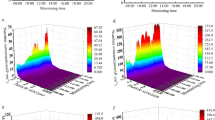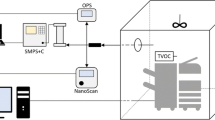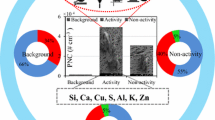Abstract
Purpose
Various publications indicate that the operation of laser printers and photocopiers may be associated with health effects due to the release of gaseous components and fine and ultrafine particles (UFP). However, only sparse studies are available that evaluate the possible exposure of office workers to printer emissions under real conditions. Therefore, the aim of our study was to assess the exposure of office workers to particulate matter released from laser printers and photocopiers.
Methods
Concentrations of fine particles and UFP were measured before, during, and after the operation of laser printing devices in 63 office rooms throughout Germany. Additionally, the particles were characterized by electron microscopy and energy-dispersive X-ray spectroscopy.
Results
A significant increase of fine particles and UFP was identified in ambient workplace air during and after the printing processes. Particle fractions between 0.23 and 20 μm emitted by the office machines significantly affect particle mass concentrations while printing 500 pages, i.e., during the printing process, PM0.23–20, PM2.5, and PM10 concentrations increased in 43 out of the evaluated 62 office rooms investigated. Additionally, a significant increase was observed in submicrometer particles, with median particle number concentrations of 6,503 particles/cm3 before and 18,060 particles/cm3 during the printing process.
Conclusions
Our data indicate that laser printers and photocopiers could be a relevant source of fine particles and particularly UFP in office rooms.




Similar content being viewed by others
References
Barthel M, Pedan V, Hahn O, Rothhardt M, Bresch H, Jann O et al (2011) XRF-analysis of fine and ultrafine particles emitted from laser printing devices. Environ Sci Technol 45:7819–7825
BfR (2008) BfR schließt Arbeiten zur „Toner“-Problematik mit einer gesundheitlichen Bewertung möglicher Risiken durch Druckeremissionen ab. Gesundheitliche Bewertung Nr. 014/2008 vom 31. März 2008. Press release, Berlin
Caesar T, Schmitt T (2009) Entwicklung eines Filters für Laserdrucker, Fax- und Kopiergeräte als wirkungsvoller Schutz vor Fein- und Tonerstaub in Innenräumen. Gefahrst Reinhalt L 69:110–114
Cheng YH (2008) Comparison of the TSI Model 8520 and Grimm Series 1.108 portable aerosol instruments used to monitor particulate matter in an iron foundry. J Occup Environ Hyg 5:157–168
Destaillats H, Maddalena RL, Singer BC, Hodgson AT, McKone TE (2008) Indoor pollutants emitted by office equipment: a review of reported data and information needs. Atmos Environ 42:1371–1388
ECMA International (2007) Standard ECMA-328. Determination of chemical emission rates from electronic equipment, 3rd edn. ECMA International, Geneva
Ewers U, Nowak D (2006) Health hazards caused by emissions of laser printers and copiers? Gefahrst Reinhalt L 66:203–210
Fiedler J, Kura J, Moriske HJ, Pietsch A (2009) Freisetzung feiner und ultrafeiner Partikeln aus Laserdruckern unter Realraumbedingungen. Gefahrst Reinhalt L 69:77–82
Fromme H, Twardella D, Dietrich S, Heitmann D, Schierl R, Liebl B et al (2007) Particulate matter in the indoor air of classrooms: exploratory results from Munich and surrounding area. Atmos Environ 41:854–866
Gadhia PK, Patel D, Solanki KB, Tamakuwala DN, Pithawala MA (2005) A preliminary cytogenetic and hematological study of photocopying machine operators. Indian J Occup Environ Med 9:22–25
Glytsos T, Ondráček J, Džumbová L, Kopanakis I, Lazaridis M (2010) Characterization of particulate matter concentrations during controlled indoor activities. Atmos Environ 44:1539–1549
Gminski R, Mersch-Sundermann V (2006) Gesundheitliche Bewertung der Exposition gegenüber Tonerstäuben und gegenüber Emissionen aus Laserdruckern und Kopiergeräten - Aktueller Erkenntnisstand. Umweltmed Forsch Prax 11:269–300
Gminski R, Decker K, Heinz C, Seidel A, Könczöl M, Goldenberg E et al (2011) Genotoxic effects of three selected black toner powders and their dimethyl sulfoxide extracts in cultured human epithelial A549 lung cells in vitro. Environ Mol Mutagen 52:296–309
Goud KI, Shankarapppa K, Vijayashree B, Rao K, Ahuja Y (2001) DNA damage and repair studies in individuals working with photocopying machines. Int J Hum Genet 1:139–143
Goud KI, Hasan Q, Balakrishna N, Rao KP, Ahuja YR (2004) Genotoxicity evaluation of individuals working with photocopying machines. Mutat Res 563:151–158
Hänninen O, Brüske-Hohlfeld I, Loh M, Stoeger T, Kreyling W, Schmid et al (2010) Occupational and consumer risk estimates for nanoparticles emitted by laser printers. J Nanopart Res 12:91–99
He C, Morawska L, Taplin L (2007) Particle emission characteristics of office printers. Environ Sci Technol 41:6039–6045
He C, Morawska L, Wang H, Jayaratne R, McGarry P, Johnson GR et al (2010) Quantification of the relationship between fuser roller temperature and laser printer emissions. J Aerosol Sci 41:523–530
Jaakkola MS, Yang LY, Ieromnimon A, Jaakkola JJK (2007) Office work, SBS and respiratory and sick building syndrome symptoms. Occup Environ Med 64:178–184
Kagi N, Fujii S, Horiba Y, Namiki N, Ohtani Y, Emi H et al (2007) Indoor air quality for chemical and ultrafine particle contaminants from printers. Build Environ 42:1949–1954
Koivisto AJ, Hussein T, Niemelä R, Tuomi T, Hämeri K (2010) Impact of particle emissions of new laser printers on modeled office room. Atmos Environ 44:2140–2146
Lee CW, Hsu DJ (2007) Measurements of fine and ultrafine particles formation in photocopy centers in Taiwan. Atmos Environ 41:6598–6609
Lee SC, Lam S, Fai HK (2001) Characterization of VOCs, ozone, and PM10 emissions from office equipment in an environmental chamber. Build Environ 36:837–842
Lin GHY, Mermelstein R (1994) Acute toxicity studies of Xerox reprographic toners. Int J Toxicol 13:2–20
Marconi A (2006) Fine, ultrafine and nano-particles in the living and working setting: potential health effects and measurement of inhalation exposure. G Ital Med Lav Ergon 28:258–265
McGarry P, Morawska L, He C, Jayaratne R, Falk M, Tran Q et al (2011) Exposure to particles from laser printers operating within office workplaces. Environ Sci Technol 45:6444–6452
Morawska L, Salthammer T (2003) Indoor environment: airborne particles and settled dust. Wiley-VCH, Weinheim
Morawska L, He C, Johnson G, Jayaratne R, Salthammer T, Wang H et al (2009) An investigation into the characteristics and formation mechanisms of particles originating from the operation of laser printers. Environ Sci Technol 43:1015–1022
Muñoz X, Roger A, De la Rosa D, Morell F, Cruz MJ (2007) Occupational vocal cord dysfunction due to exposure to wood dust and xerographic toner. Scand J Work Env Hea 33:153–158
Nakadate T, Yamano Y, Adachi C, Kikuchi Y, Nishiwaki Y, Nohara M et al (2006) A cross sectional study of the respiratory health of workers handling printing toner dust. Occup Environ Med 63:244–249
Nel A, Xia T, Mädler L, Li N (2006) Toxic potential of materials at the nanolevel. Science 311:622–627
Nel AE, Mädler L, Velegol D, Xia T, Hoek EM, Somasundaran P et al (2009) Understanding biophysicochemical interactions at the nano-bio interface. Nat Mater 8:543–557
Peters TM, Ott D, O'Shaughnessy PT (2006) Comparison of the Grimm 1.108 and 1.109 portable aerosol spectrometer to the TSI 3321 aerodynamic particle sizer for dry particles. Ann Occup Hyg 50:843–850
Pettersson T, Fogden A (2005) Spreading of individual toner particles studied using in situ optical microscopy. J Colloid Interface Sci 287:249–260
Rödelsperger K, Podhorsky S, Brückel B, Dahmann D, Hartfiel GD, Woitowitz HJ (2003) Physical characteristics and definitions of granular insoluble dusts. Eur J Oncol 8:103–112
Schripp T, Wensing M, Uhde E, Salthammer T, He C, Morawska L (2008) Evaluation of ultrafine particle emissions from laser printers using emission test chambers. Environ Sci Technol 42:4338–4343
Schripp T, Mulakampilly SJ, Delius W, Uhde E, Wensing M, Salthammer T et al (2009) Comparison of ultrafine particle release from hardcopy devices in emission test chambers and office rooms. Gefahrst Reinhalt L 69:71–76
Schulz H, Harder V, Ibald-Mulli A, Khandoga A, Koenig W, Krombach F et al (2005) Cardiovascular effects of fine and ultrafine particles. J Aerosol Med 18:1–22
Stefaniak AB, Breysse PN, Murray MPM, Rooney BC, Schaefer J (2000) An evaluation of employee exposure to volatile organic compounds in three photocopy centers. Environ Res 83:162–173
Wensing M, Schripp T, Uhde E, Salthammer T (2008) Ultra-fine particles release from hardcopy devices: sources, real-room measurements and efficiency of filter accessories. Sci Total Environ 407:418–427
Wolkoff P (1999) Photocopiers and indoor air pollution. Atmos Environ 33:2129–2130
Wolkoff P, Johnsen CR, Franck C, Wilhardt P, Albrechtsen O (1992) A study of human reactions to office machines in a climatic chamber. J Expo Anal Env Epid 1:71–97
Acknowledgments
We thank Thomas Eikmann, Caroline Herr, and Anja zur Nieden from the Department Hygiene and Environmental Health for their valuable help in examining the office workers regarding health effects as well as Anja Schnecko, Department of Environmental and Indoor Toxicology of the Gießen University Medical Center. Additionally, we thank numerous colleagues, especially Michael Wensing, Günter Oberdörster, Hans-Jörn Moriske, and Christine Däumling, who critically reviewed our data and discussed the outcome and implications with us within the BfR risk assessment process. Furthermore, we cordially thank Joachim Schneider, Bernd Brückel, and Klaus Rödelsperger from the Department of Occupational Medicine at Gießen University Medical Centre for the electron microscope analysis. Klaus Rödelsperger, expert for TEM and REM analysis, sadly died unexpectedly during the study. Additionally, we thank Dirk Bültermann, Thomas Kreis, and Hans von Rechenberg for their valuable contribution as occupational physicians. Last but not the least, we thank the heads of the office units who contributed to the study, i.e., allowed us to perform parts of the study in their buildings.
The research project was funded by the German Federal Environment Agency and the German Federal Institute for Risk Assessment, Berlin.
Author information
Authors and Affiliations
Corresponding author
Additional information
Responsible editor: Euripides Stephanou
Electronic supplementary material
Below is the link to the electronic supplementary material.
ESM doc
(DOC 858 kb)
Rights and permissions
About this article
Cite this article
Tang, T., Hurraß, J., Gminski, R. et al. Fine and ultrafine particles emitted from laser printers as indoor air contaminants in German offices. Environ Sci Pollut Res 19, 3840–3849 (2012). https://doi.org/10.1007/s11356-011-0647-5
Received:
Accepted:
Published:
Issue Date:
DOI: https://doi.org/10.1007/s11356-011-0647-5




